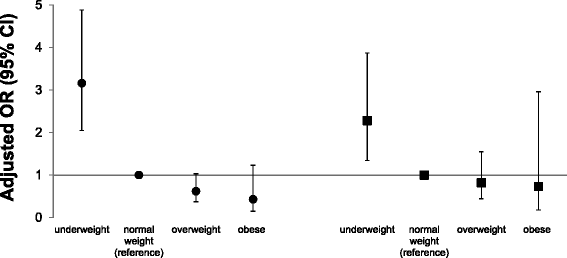Longitudinal association between preschool fussy eating and body composition at 6 years of age: The Generation R Study
- PMID: 26666996
- PMCID: PMC4678491
- DOI: 10.1186/s12966-015-0313-2
Longitudinal association between preschool fussy eating and body composition at 6 years of age: The Generation R Study
Abstract
Background: Children's fussy eating behavior has been related to both underweight and overweight in cross-sectional studies, but the direction of these associations and the relation with more detailed measures of body composition remains unclear. We aimed to examine whether fussy eating at age 4 years is longitudinally related to body mass index (BMI), fat mass index (FMI) and fat-free mass index (FFMI) at 6 years of age.
Methods: This study was embedded in Generation R, a population-based, prospective cohort. Data were available for 4191 children. The Children's Eating Behaviour Questionnaire (CEBQ), administered at age 4 years, was used to derive a fussy eating profile. This profile is characterized by high scores on food avoidant scales and low scores on food approach scales. At age 6 years, height and weight were measured at our research center. Body fat and fat-free mass were measured using Dual-energy-X-ray absorptiometry. We used age- and sex-specific standard deviation scores (SDS) for all outcomes.
Results: After adjustment for confounders, the fussy eating profile was related to lower BMI-SDS (B = -0.37, 95% CI: -0.47;-0.26), lower FMI-SDS (B = -0.22, 95 % CI: -0.33;-0.12) and lower FFMI-SDS (B = -0.41, 95% CI: -0.54;-0.29). When adjusting for baseline BMI at 4 years, the fussy eating profile predicted a 0.11 lower BMI-SDS at age 6 (95% CI: -0.19;-0.04). This change in BMI was mainly due to a decrease in FFMI (B = -0.19, 95% CI: -0.29;-0.09). Fussy eaters also had a higher risk of becoming underweight than non-fussy eaters (OR = 2.28, 95% CI: 1.34;3.87).
Conclusions: Our findings suggest that young fussy eaters are at risk of having a lower fat free mass and of becoming underweight over a 2-year period. This implies that fussy eaters may benefit from careful monitoring to prevent an adverse growth development.
Figures
References
Publication types
MeSH terms
LinkOut - more resources
Full Text Sources
Other Literature Sources


